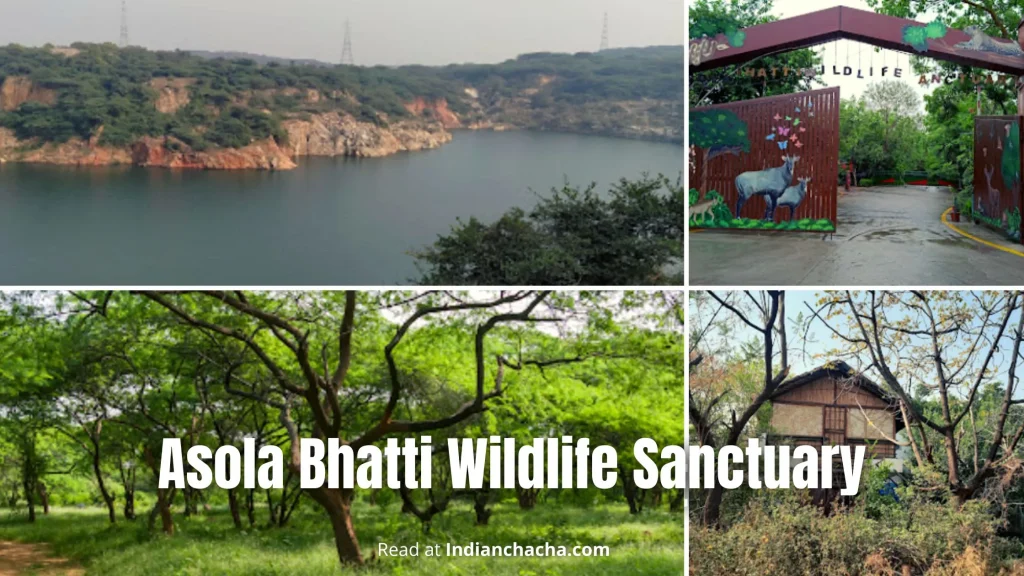Asola Bhatti Wildlife Sanctuary is the place of refreshing your Mind with Nature in the Delhi Haryana border area.
So, do you want to visit Asola Bhatti Wildlife Sanctuary? But, before, visiting the sanctuary, you need to know some details of the sanctuary, which I have written in this article.
Hello Buddy, I’m Somraj Mondal, the Content Developer at indianchacha.com. In this blog post, I will show you complete details of the Asola Bhatti Wildlife Sanctuary.
Here, you will know about,
- History of the Sanctuary
- Flora and fauna sanctuaries
- Best time to visit
- And, much more information
So, let’s dive right in.
Table of Contents
Asola Bhatti Wildlife Sanctuary, Delhi Overview
Asola Bhatti Wildlife Sanctuary is a beautiful biodiversity zone, covering an area of 32.71 km2, located in the South Delhi Ridge of the Aravalli hill range on the Delhi-Haryana border, located in southern Delhi. The sanctuary is part of the Southern Ridge and has biodiversity significance as it merges with the Indo-Gangetic Plain.
It is an important part of the North Aravalli Leopard Wildlife Corridor which starts from Sariska National Park in Rajasthan, passes through various districts of Haryana, and finally meets the Delhi Ridge. Conserving the goodness of nature and providing a home to many wildlife, mammals, birds, and many other species, this is one of the best Bird sanctuaries in Delhi which represent the last surviving remnants of the Delhi Ridge hill range, it is the semi-forest and Habitat Wildlife Sanctuary.
Asola Bhatti Wildlife Sanctuary is a perfect destination for wildlife enthusiasts, like me. The sanctuary is currently under the Conservation Education Center (CEC) in Delhi. CEC is actively engaged in imparting conservation education to students and professionals through field-based education programs.
Establishing the Wildlife Sanctuary in 1986. the Asola Bhatti Wildlife Sanctuary has many historical sites the sanctuaries are Surajkund and Anangpur Dam, Tughlakabad Fort, and Adilabad Ruins, Chhatarpur Temple. There are three villages Maidangiri, Asola, and Shapur within the sanctuary, and also Dozens of lakes that have formed in abandoned open pit mines in and around the sanctuary.
History of Asola Bhatti Wildlife Sanctuary
The name sanctuary derives its name from Asola village near Tughlakabad in Delhi. Now, The legally protected status of the southern hills remained uncertain until 1986 when the community lands (4707 acres) and Bhati lands (2167 acres) of Asola, Shapur, and Maidangadi villages were notified. And, finally, in 1991, it was officially renamed Asola Bhatti Wildlife Sanctuary.
Earlier the area of the sanctuary had a history of illegal mining of Lal Badarpur sand and stone which was in high demand for construction activities and construction. Hence the area came to be known as Bhati Khani. Across the sanctuary are several large open and deep pits, abandoned mine pits, now turned into lakes.
Flora and Fauna of the Asola Bhatti Wildlife Sanctuary
Flora:
There are much flora are found in the Asola Bhatti Wildlife Sanctuary. Some of the commonly founds plant species of the sanctuary are Butia monosperma (Flame of the Forest), Indian Elm, Neolamarkia cadamba (Kadamba), Tinospora cordifolia (Giloi), Rhytia tinctoria (Inderzao), Anozysus (Dhok), Prosopis cinerea (Jand) and many more.
Fauna:
Asola Bhatti Wildlife Sanctuary is an important habitat for the Indian leopard. In addition, there are many Endangered species in the sanctuary including the red-headed vulture and the Egyptian vulture found here. The Haryana government has conducted a vulture conservation program in the sanctuary. Near-threatened species include the painted stork, white-faced ibis, and European roller. Some Rare birds of the sanctuary are black francolins and grey-headed fish eagles.
The Gurugram-Faridabad highway bisects these wildlife areas, often resulting in accidental deaths of wildlife, including leopards. The Wildlife Institute of India announced that they would conduct leopard and wildlife surveys In January 2019, using camera traps and, pugmarks followed by tracking of leopards and foxes via radio collars.
According to a 2019 survey by the Bombay Natural History Society (BNHS), there are 27 species from 14 families found in the area, the number of golden foxes has doubled from 8 to 19 in an 8 km tract where rats and rabbits are their prey bases.
Things to do at Asola Bhatti Wildlife Sanctuary
1. Visit the Butterfly Park
The sanctuary is a complete paradise for nature lovers as they can see a wide range of flora, fauna, and Butterflies. Spreading across 2.5 acres, there are more than 60 species of Butterfly found in the Butterfly Park. It looks beautiful by seeing the Colorful Butterfly in the native plants, host plants, and nectar plants. The park is an initiative of the Delhi government to spread awareness about butterflies and help nature enthusiasts in Delhi get closer to nature.
2. Visit the nursery
There are several nurseries are set up in the Asola Bhatti Wildlife Sanctuary where CECs preserve and grow native trees which they then plant around the city. There are many Herbs and native plants grown in the Nurseries, and these are a great places for butterfly, bee, and dragonfly species.
3. On a Bicycle Explore the biodiversity
Bicycling in the Sanctuary is the new attraction of the Asala Bhati Wildlife Sanctuary. There is a 3 km-long Neem Talav cycle track there. The cycle track passing through the lush Aravalli forest will make your journey enjoyable and give you a great view of the surrounding flora and fauna.
4. Exploring Neeli Jheel
As we already know, the sanctuary has many lakes. Neeli Lake is one of them and also it is one of the main attractions of the Asala Bhatti Wildlife Sanctuary. A quarry lake is located 16 km from Butterfly Park. The trail is not well marked, and hence there is a high chance of getting lost. Also, the mobile network is weak. Hence, GPS will not be helpful. The lake is huge and pristine and can serve as a great picnic spot in winter. By the way, do not try to swim in the lake, it is a very deep lake and not ideal for swimming.
Restoration projects
In 2000, the Environment Department of Delhi government initiated a 5-year rehabilitation of 2,100 acres of the Bhati wildlife area at a cost of Rs 823 lakh.19 lakhs for 3 years with an additional expenditure of Rs. As of 31 March 2006, 700,000 saplings had been planted. The duration of the project was extended by another 3 years. A second Eco Task Force was created for the 5000-acre Asola Wildlife Sanctuary.
On the other hand, in 2019, the Haryana government is also taking conservation work within sanctuaries and ESZs including the establishment of ESZs, rainwater harvesting, restoration of degraded land and habitats, and agroforestry, herbaceous plants, etc.
Asola Bhatti Wildlife Sanctuary Ticket Price, Timing
Ticket Price:
The Entry fees of the Asola Bhatti Wildlife Sanctuary are free of Cost.
Asola Bhatti Wildlife Sanctuary Timing:
| Day | Timing |
|---|---|
| Monday | 6 AM–2 PM |
| Tuesday | 6 AM–2 PM |
| Wednesday | 6 AM–2 PM |
| Thursday | 6 AM–2 PM |
| Friday | 6 AM–2 PM |
| Saturday | 6 AM–2 PM |
| Sunday | Closed |
Best Time To Visit Asola Bhatti Wildlife Sanctuary
The Best time to visit Asola Bhatti Wildlife Sanctuary is between the months of October and March. Though, you can visit the sanctuary throughout the year and meet the many species of Wildlife. But, this month, you can get a chance in the sanctuary to resonate with the sounds of baby animals making it the best time to visit Asala Bhatti Wildlife Sanctuary. During this period, the tour offers a lot of exciting and unforgettable experiences like new baby plants, Migratory Birds, birds chirping, colorful butterflies flying in the air, etc.
How to reach Asola Bhatti Wildlife Sanctuary
The distance between Asola Bhatti Wildlife Sanctuary and Delhi is about 40 km and also the distance from the Indira Gandhi International Airport is around 21 km. After reaching the Airport, you need to take the local car to reach the sanctuary which takes around 2 to 2.5 hours, a metro will drop you at Badarpur, South Delhi, or you can reach in your car which will take around 1 hour 31 km.
It will be good to rent a Cab for to reach Asola Bhatti Wildlife Sanctuary without facing any inconvenience if you are new in Delhi. It takes less than 45 minutes to reach the airport.
Location in Google Map:
Tips For Visiting Asola Bhatti Wildlife Sanctuary
It is better to take proper precautions before you visit the Asola Bhatti Wildlife Sanctuary. Here are some tips for visiting there.
- Your trip will be more successful and convenient if you take the help of instructors.
- Don’t carry any sharp objects, lighters, alcohol, luggage bags, etc.
- Carry at least one ID proof and first aid kit while traveling.
- Carry some fast food with enough water with you to keep you hydrated.
- It is recommended to wear sturdy jungle boots to prevent thorns.
- Don’t carry heavy bags if you want to explore and enjoy the sanctuary at its best.
Threats at Sanctuary
1. Bandwari Waste to Energy Plant and Landfill
Closed landfills and waste plants are causing environmental pollution in this wildlife sanctuary are which I very harmful to animals and plants. A waste-to-energy plant on which the government has already spent Rs.300 crore with another INR400 crore being used to dump toxic waste along with two sand mining pits, has posed a serious environmental threat to the sensitive environment. In 2017, the National Green Tribunal (NGT) asked the Central Pollution Control Board (CPCB) to test groundwater samples near the Bandhwari plant as the landfill site has runoff of dirty black water pollution into water bodies and leeches in the area’s forests.
2. Water shortage
In the Aravalli hill forest on the Gurugram-Faridabad side, there is a lack of water supply, and wild animals are scarce. In 2018, The Haryana government takes a step to conserve rainwater in the Moonsson season, that’s help to supply enough water in the summer months In January 2019, the government announced plans to perennialize the pit by connecting it to a pipeline from a nearby village.
3. The presence of wildlife is officially denied
There are some Human activities such as polluted vegetation and unplanned urbanization are also major threats to the sanctuary. Government officials are often reluctant and in denial about the presence of wildlife, such as leopards so that forests can be exploited for intrusive human development.
Conclusion
To sum up, Asola Bhatti Wildlife Sanctuary is one of the most amazing places on the Delhi-Harayana Border to explore much wildlife. I hope you got the necessary information about Asola Bhatti Wildlife Sanctuary from this article before visiting the sanctuary.
Now, I’d like to know from you:
Are you belong to Delhi or any other city?
Have you already visited or ready to explore the sanctuary?
Let me know in the comments now.
Visit Other Sanctuary:
- Purbasthali Bird Sanctuary
- Nandur Madhmeshwar Bird Sanctuary
- Koonthakulam Bird Sanctuary
- Chinnar Wildlife Sanctuary
- Ballavpur Wildlife Sanctuary
- Coringa Wildlife Sanctuary
- Pobitora Wildlife Sanctuary
- Chitrangudi Bird Sanctuary
- Bethuadahari Wildlife Sanctuary
- Soor Sarovar Bird Sanctuary
- Bhadra Wildlife Sanctuary
- Mayani Bird Sanctuary
- Bibhutibhushan Wildlife Sanctuary
- Sandi Bird Sanctuary
- Chintamoni Kar Bird Sanctuary
- Chapramari Wildlife Sanctuary
- Dandeli Wildlife Sanctuary
- Point Calimere Bird Sanctuary
- Thol Lake Bird Sanctuary
- Nal Sarovar Bird Sanctuary
- Senchal Wildlife Sanctuary
- Nawabganj Bird Sanctuary
- Patna Bird Sanctuary
- Vedanthangal Bird Sanctuary
- Raiganj Wildlife Sanctuary
- Mahananda Wildlife Sanctuary
- Karnala Bird Sanctuary
- Ramnabagan Wildlife Sanctuary

Somraj Mondal is an Extensive experience in SEO and Travel, Lifestyle, and Bird Enthusiast expert of Indianchacha. A professional Blogger who loves to explore new places, and new cultures.

